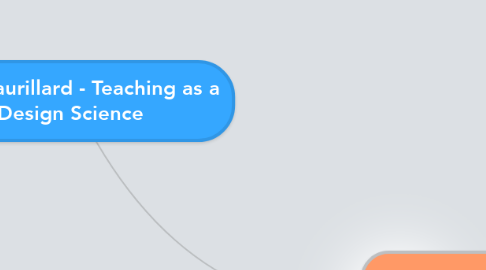
1. Chapter 5 - What it takes to teach.
1.1. Factors influencing the design of teaching
1.1.1. There must be coherence between the learner's and the teacher's expected outcomes. The teacher can influence those goals by designing his teaching context properly.
1.1.2. Design begins with the teacher's aims for the course. They are influenced by:
1.1.2.1. Professional qualifications
1.1.2.2. Personal interests
1.1.2.3. Standardized requirements
1.1.2.4. Expected students' skills
1.1.2.5. Time available and other logistics
1.1.2.6. Students' interests
1.1.3. Design continues with expected learning outcomes and curriculum requirements.
1.1.3.1. Here again, students' expectations and interests influence design.
1.1.4. Learning and assessment activities are designed taking into account the previous steps.
1.1.5. The teaching learning process is iterative: feedback loops are a constant all over the model.
1.1.5.1. This links to the "reflective practice" chapter at the beginning of the course.
1.1.6. Even though the proposed model coincides with most of the literature covering the planning/design of teaching-learning environments, most course proposals in HE do not include analyses of student's learning needs.
1.2. Approaches to designing for learning
1.2.1. 1st clarification: learning CANNOT be designed. You can try to design in order to make learning possible, which is different.
1.2.2. Common problem within "instructional design" literature.
1.2.2.1. Overwhelming variety of models, diagrams, approaches and alternatives. (The supermarket paralysis).
1.2.2.1.1. PLUS: there is little consensus within them. Some authors stand out (see page 67), but there is still lack of common threads.
1.2.2.1.2. Entwistle and Smith (2002, cited by Laurillard) made a similar critique: Models seem to contradict each other and may even appear unrealistic and detached of actual classroom contexts.
1.2.3. Attempts to offer guidelines on instructional design have, so far, departed from the pedagogical concepts of learning (Ch 4). The author will continue that approach.
1.2.4. In order to assist the learner in completing his learning cycles, the teacher is suggested to:
1.2.4.1. Align teacher learner goals
1.2.4.2. Set goals that use concepts available to the pupil.
1.2.4.3. Clarify concepts to ease knowledge organization.
1.2.4.4. Build an appropriate environment
1.2.4.5. Monitor the building and use of concepts
1.2.4.6. Offer meaningful feedback
1.3. Aligning goals, activities and assessment
1.3.1. The learning aims have to make sense to the students, they have to be purposeful.
1.3.1.1. To achieve this, Ausubel suggests (read p68)
1.3.1.1.1. Begin with a comment that relates to the learner's own experience.
1.3.1.1.2. Use an intriguing question for which the instruction serves as an explanation.
1.3.1.2. Dewey's more radical approach (1938)
1.3.1.2.1. Goals should be discussed and negotiated with the learner.
1.3.2. There must be internal coherence among what you want for a course, what you teach, the way you teach it, and the activities and assessment strategies implemented.
1.3.2.1. Alignment is unobjectionable. The question is HOW?
1.3.2.1.1. So far, teachers have used language trying to address alignment.
1.3.2.2. Teachers must look at the whole picture when trying to address alignment.
1.3.2.2.1. -Goals -Knowledge -Action -Feedback -Modulation
1.3.2.3. Alignment is unobjectionable. The question is HOW?
1.4. Monitoring Alternative Conceptions
1.4.1. Curriculum design implies an awareness of the appropriate sequence of concepts and knowledge. FQ's
1.4.1.1. Which concepts are needed?
1.4.1.2. Which misconceptions are frequent?
1.4.1.3. How difficult/easy is it to grasp?
1.4.1.4. What do students know?
1.4.2. One main teaching principle drawn from "How people learn" (Bransford, Brown and Cocking, 2003, Cited by Laurillard, 2012:71)
1.4.2.1. 1. Teachers should use the students' previous knowledge as a departure point.
1.4.2.1.1. This requires us to:
1.4.2.1.2. Other theorists and experiments agree with this principle. (pp 71-72)
1.4.3. Conclusion: Rather than homogenizing pupil's conceptions into his own, the teacher should monitor alternative conceptions. This requires us to go beyond prior-conceptions. (Laurillard, 2012:72)
1.5. Scaffolding Theory-generated Practice
1.5.1. The student should be allowed spaces to practice, self-assess and improve.
1.5.1.1. This requires teachers to:
1.5.1.1.1. Deconstruct complex actions to make them more accessible to the learner.
1.5.1.1.2. Provide an environment that promotes practice, testing and improvement of actions.
1.5.1.1.3. Offer meaningful feedback to their actions.
1.5.1.2. Meaningful feedback that encourages improvement faces 2 problems
1.5.1.2.1. Pedagogical
1.5.1.2.2. Logistical
1.6. Fostering conceptual change
1.6.1. Designing a practice-oriented learning environment is difficult and time-consuming
1.6.1.1. Teachers opt for presentations, texts and other representations to increase time efficiency.
1.6.2. There are concepts that might be well described as "counter-intuitive".
1.6.2.1. The teacher must understand the underlying misconception to design activities that allow conceptual change.
1.6.2.1.1. Bridging strategy
1.6.2.1.2. Cognitive conflict
1.6.2.1.3. Architecture of variation
1.6.3. Achievements attained in one learning process (approaches, lessons, skills, concepts, etc) become the background for a new iterative process in a continuous cycle.
1.6.3.1. Confronting and disproving the students' predictions might be the best strategy to allow for conceptual change.
1.7. Encouraging Metacognition
1.7.1. Only through reflection on one's actions can there be learning.
1.7.1.1. The teacher can foster it, but at the end it is done autonomously by the learner.
1.7.1.1.1. Whether reflection is being done or not can only be judged from inferences, not from observation.
1.7.1.2. This type of approach to learning has been named "meta-cognitive", as it critically looks one's own cognition from above, as a trial and error process.
1.7.1.2.1. The teacher should open spaces for the students to self-direct their actions, and other spaces for the meta-cognitive reflection.
1.8. Teaching as design
1.8.1. There are always some general guidelines on how to rightly undertake instructional design, but they are vague and sometimes subjective.
1.8.1.1. In order to nurture your pedagogical practice, there is only one option: keep on learning.
1.8.2. Why does teaching involve design?
1.8.2.1. "Everyone designs who devises courses of action aiming at changing existing situations into desired ones." (Simon, 1969:129, Cited by Laurillard 2012: 78)
1.8.2.1.1. Sources:
1.8.2.2. Marton Proposes a set of steps toward this (p78)
1.8.2.2.1. Define aims
1.8.2.2.2. Design teaching
1.8.2.2.3. Teach according to plan
1.8.2.2.4. Evaluate effectiveness
1.8.2.2.5. Spread lessons learned
1.8.2.3. Teachers need to be experiential learners and improve their practice using other colleagues' experiences as well.
